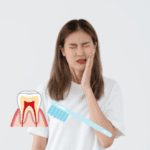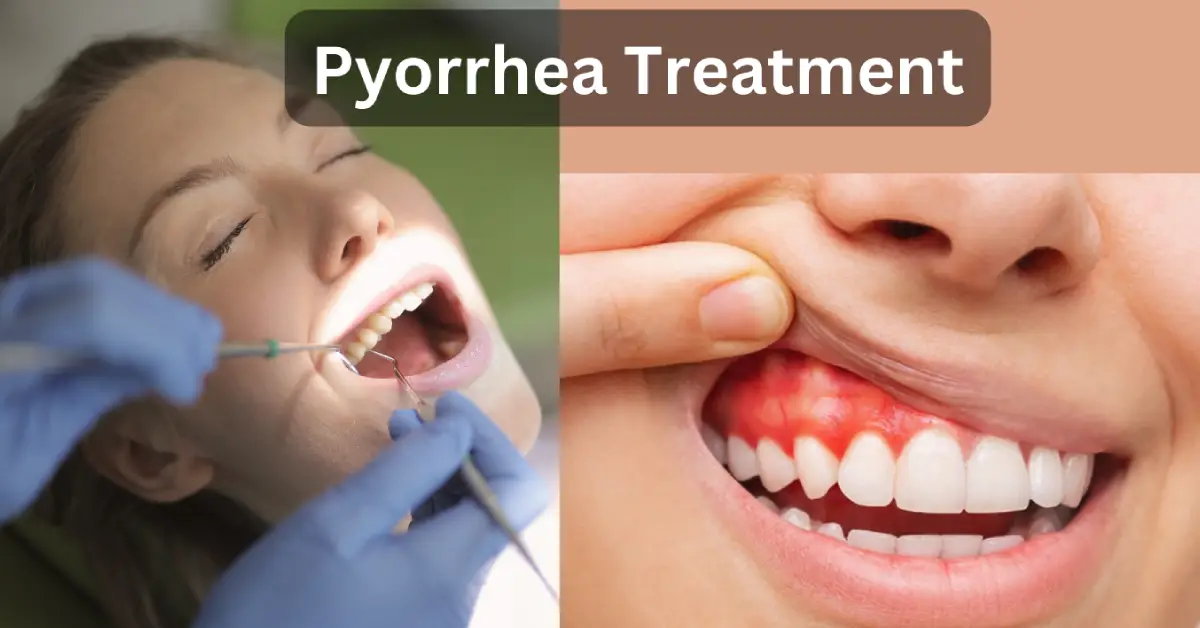Introduction
Pyorrhea treatment: Have you ever experienced bleeding gums while brushing your teeth? It might be more than just aggressive brushing. Pyorrhea, or periodontitis, is a severe gum infection that can damage the soft tissue and destroy the bone that supports your teeth. This comprehensive guide will cover what Pyorrhea is, its symptoms, various treatment options including home remedies, and the costs involved. Let’s dive in to help you maintain a healthy smile!
Contents
What is Pyorrhea?
Pyorrhea, also known as periodontitis, is an advanced form of gum disease that starts with gingivitis. It occurs when the bacteria in plaque (a sticky, colorless film that forms on your teeth) cause the gums to become inflamed. Untreated leads to tooth loss & more.
Causes of Pyorrhea
- Poor oral hygiene
- Smoking or using tobacco
- Hormonal changes, particularly in women
- Certain illnesses such as diabetes
- Medications that reduce saliva flow
- Genetic predisposition
Symptoms of Pyorrhea
Being aware of the symptoms can help you catch Pyorrhea early and seek appropriate treatment.
Early Symptoms
- Red, swollen gums
- Bleeding gums during and after brushing
- Persistent bad breath (halitosis)
Advanced Symptoms
- Receding gums, making teeth appear longer
- Deep Gum Pockets Form
- Loose or shifting teeth
When to Consult a Dentist
If you experience any of these symptoms, Get Checked Now. Early intervention can prevent severe damage and tooth loss.
Diagnosis of Pyorrhea
Accurate diagnosis is essential for effective treatment.
Dental Examination
A comprehensive dental exam will include checking your gums for bleeding, swelling, and the depth of pockets around your teeth.
Imaging Tests
X-rays can help to assess bone loss in areas where your dentist sees deeper pockets.
Laboratory Tests
In certain cases, additional tests may be conducted to identify specific bacteria or underlying health issues contributing to the disease.
Pyorrhea Treatment Options
Treatment options for Pyorrhea range from professional dental procedures to home remedies. Here’s an overview of the various approaches.
Key Points:
- Plaque and Tartar Removal: Eliminates buildup from above and below the gum line.
- Root Surface Smoothing: Smooths the root surfaces to promote healing.
- Deep-Cleaning Procedure: Thorough cleaning to enhance oral health and prevent gum disease.
Professional Dental Treatments
Scaling and Root Planing
This deep-cleaning procedure involves removing plaque and tartar from above and below the gum line and smoothing the root surfaces to promote healing.
Antibiotic Therapy
Antibiotics may be used to help control bacterial infection. These can come in the form of mouth rinses, gels placed between the teeth and gums or into pockets, or oral medications.
Surgical Treatments
For advanced cases, surgical interventions may be necessary to restore supportive tissues.
Flap Surgery
The gums are lifted back to remove tartar and then sutured back in place for healing.
Bone and Tissue Grafts
These involve using natural or synthetic materials to replace or encourage the regeneration of bone and gum tissue.
Guided Tissue Regeneration
This procedure stimulates bone and gum tissue growth to restore lost structures supporting the teeth.
Home Remedies for Pyorrhea
While professional treatment is critical, home remedies can support overall oral health and manage mild cases.
Oral Hygiene
Proper Brushing Technique
- Use a soft-bristled toothbrush and fluoride toothpaste. Brush at least twice a day using gentle, circular motions.
- Make alum powder and apply it to gums, mix it in water, and gargle
Effective Flossing Methods
Use floss every day to remove plaque and food particles from between your teeth and beneath your gums..
Recommended Mouthwashes
Use an antimicrobial mouthwash to help reduce
Common Myths About Pyorrhea–
There are many misconceptions about Pyorrhea. Let’s debunk some of these myths to help you understand the reality of this gum disease.
Myth 1: Pyorrhea Only Affects Older Adults
While it’s true that the risk of gum disease increases with age, Pyorrhea can affect anyone, including teenagers. Poor oral hygiene and other risk factors can cause Pyorrhea at any age.
Myth 2: Bleeding Gums Are Normal
Many people believe that bleeding gums are a normal occurrence, especially when brushing or flossing. However, bleeding gums are often a sign of gum disease and should not be ignored.
Myth 3: Good Oral Hygiene Alone Can Prevent Pyorrhea
Good oral hygiene is crucial, but it’s not always enough to prevent Pyorrhea. Regular dental check-ups and professional cleanings are essential to remove plaque and tartar that can’t be eliminated by brushing and flossing alone.
Myth 4: Pyorrhea is Irreversible
Early stages of gum disease can often be reversed with good oral hygiene and professional treatment. Even advanced Pyorrhea can be managed and controlled to prevent further damage.
Myth 5: Dental Treatment for Pyorrhea is Painful
Modern dental techniques and anesthesia have made Pyorrhea treatments much more comfortable than they were in the past. Your dentist will work to ensure you’re comfortable throughout your treatment.
Hydrogen Peroxide Rinse: While not a cure-all, a diluted hydrogen peroxide rinse can help with bleeding gums. Mix equal parts 3% hydrogen peroxide with water, swish for 30 seconds, and spit. Avoid swallowing! This can help reduce plaque and kill bacteria that contribute to gum inflammation. Remember, it’s not a replacement for brushing and flossing, but can be a helpful addition to your routine.
Important Note: Always dilute hydrogen peroxide before using it in your mouth. Full-strength hydrogen peroxide can irritate your gums.
See a Dentist: If your gums bleed frequently, it’s important to see a dentist to diagnose the underlying cause and get proper treatment.
Conclusion
Pyorrhea, or periodontitis, is a serious gum disease that can lead to significant oral health problems if left untreated. Understanding the symptoms, seeking early diagnosis, and pursuing appropriate treatment can prevent severe damage and maintain your oral health. From professional dental treatments to effective home remedies, there are numerous ways to manage and prevent Pyorrhea. Regular dental visits, a robust oral hygiene routine, and lifestyle adjustments are key to keeping this gum disease at bay.
FAQs,
What are the initial signs of Pyorrhea?

Initial signs include red, swollen gums, bleeding during brushing, and persistent bad breath.
Can home remedies alone cure Pyorrhea?
Home remedies can help manage mild cases and support professional treatment, but they cannot cure advanced Pyorrhea on their own.
How frequently should I visit the dentist if I have Pyorrhea?
It is recommended to see your dentist every three to four months for check-ups and cleanings if you have Pyorrhea.
Does dental insurance cover Pyorrhea treatment?
Many dental insurance plans cover part of the treatment costs for Pyorrhea. It’s best to check with your insurance provider.
What dietary changes can help prevent Pyorrhea?
Avoid sugary snacks and beverages, and incorporate foods rich in fiber, vitamins, and minerals, such as crunchy fruits and vegetables, dairy products, and green tea to support oral health.


4 thoughts on “Pyorrhea Treatment: Symptoms, Home Remedies, and Costs”